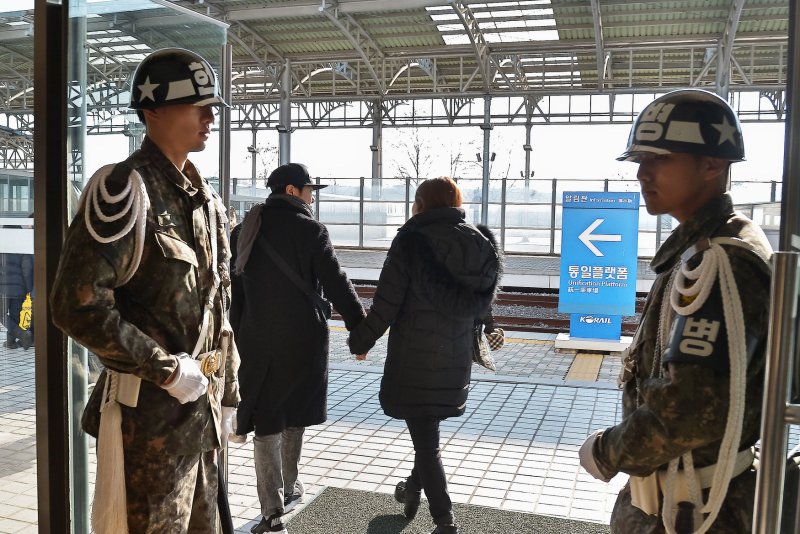South Korean soldiers stand guard at the Dorasan Station in the Civilian Control area near the demilitarized zone in Paju, South Korea, near the checkpoints where South Korean businesspeople moved through to access the Kaesong Industrial Complex in North Korea. File Photo by Keizo Mori/UPI |
License Photo
NEW YORK, Dec. 22 (UPI) -- The shutdown of a jointly operated factory park in North Korea was a misstep in inter-Korea relations, according to a South Korean North Korean studies scholar who has proposed a "Seoul-Pyongyang megacity" as a vision for the peninsula.
Min Kyung-tae, a visiting research fellow at the Institute for Far Eastern Studies at Kyungnam University, told UPI by Skype on Friday that South Korea lost significant leverage over the North by abruptly leaving Kaesong.
He also described the decision to leave, made by former President Park Geun-hye, as "unfortunate" and misguided.
"If you actually look at the channels of use for South Korean payments to Kaesong, a lot of the funds were being used to operate the factory park, to cover actual costs," Min said, adding several analysts have tracked how the funds were being used.
The Seoul-Pyongyang Megacity author also pointed out the closure of Kaesong has not had an impact on North Korea's weapons development.
"It's difficult to say South Korea payments for Kaesong alone changed the direction of North Korea's munitions industry," Min said. "Even at present, when the Kaesong complex has been suspended along with North-South cooperation, North Korea's weapons development has not stopped."
"It is hard to build a direct connection between the two."
The analyst also said South Korea payments to North Korea for Kaesong, in proportion to the North Korean economy, or compared to North Korea's trade with China is "really meager."
"By pre-emptively suspending Kaesong, any leverage South Korea would have had over the North, may have been lost," Min said. "I find that most unfortunate."
Seoul suspended operations at Kaesong in February 2016, after officials of the former Park Geun-hye administration said the revenue North Korea earned from factories was being used to fund Pyongyang's nuclear weapons program.
Businesses were profitable. In 2015, more than $515 million worth of textiles, electronic parts and other goods were produced at the factories.
The reopening of Kaesong, however, is a remote possibility.
A move to resume operations could be found in violation of United Nations Security Council sanctions resolutions, and North Korea is under the heaviest sanctions in its history.
But Min, a former Samsung engineer who once worked in Korea's booming construction industry, sees Kaesong as an important symbol of progress, the kind of development that could eventually bring the two Koreas together well before political unification.
His book, now on its third reprint in South Korea, was first published in 2014.
Min said his message has not changed, although relations between North and South "have worsened" since the first publication.
The book, currently available only in Korean, explores how two cities proximal to each other are naturally made for cooperation.
Kaesong provides an early prototype of mutual exchange, and similarly Seoul and Pyongyang, the two capital cities on the peninsula, could be connected through a network of cities, or a "megacity," a concept that is being placed into widespread practice across Asia, in countries like China.
"The example I give in the book is Hong Kong and Shenzhen," Min said. "Cooperation began during Hong Kong's colonial period."
The economic ties between Hong Kong during British colonial rule and the mainland Chinese city eventually played an important role after the handover of Hong Kong to China.
A "megacity" was later formed in China's Pearl River Delta with the emergence of Guangzhou and Zhuhai, and a similar synergy could help the Koreas connect, the analyst said.
"By 2030, it would be good to have this kind of progress between North and South."
Min said his South Korean readers have responded positively and said they were "very interested" in the megacity concept for the Koreas, a novel idea that could regain traction, should tensions subside on the peninsula.
The analyst said South Koreans have lived with North Korea's threats for decades, and already faced potential danger long before North Korea decided to pursue nuclear weapons.
"South Korea has always been aware of North Korea's threats," Min said. "But both sides realize they don't want war."
The desire to avert conflict is why dialogue with North Korea and persuading the Kim Jong Un regime to "change in a positive way," are important, and appeals to South Koreans with progressive views.
"North Korea economic reform can benefit many countries," Min said. "They can share in its success."
Min also said economic cooperation will bridge the land-based and maritime powers -- China and Russia on one side, the United States and Japan on the other -- and the peninsula could play a bridge role.
"The missing link is North Korea," he said, adding with North Korea, a Eurasia network could be built, and the region transformed.















